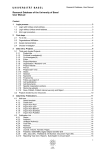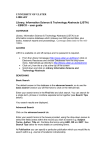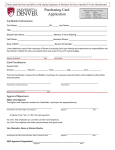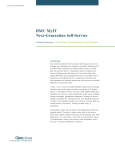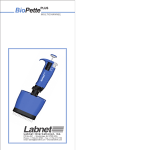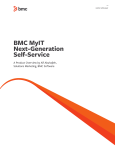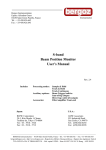Download WORQS Manual - College of Agricultural, Human, and Natural
Transcript
WORQS WSU Online Faculty & Administrative Professional Review and Query System https://worqs.wsu.edu/ Contact: Brandon Burch, [email protected], 509-335-5516 User’s Manual WORQS (WSU Online Review and Query System) is Washington State University’s standardized Web-based procedure for faculty to self-report information for their annual review. The system was designed, developed, and tested by Extension Communication and Education Support in the College of Agricultural, Human, and Natural Resource Sciences. To access the forms you need a WSU network ID and password enabled for Active Directory. If you do not have an Active Directory-enabled network ID, or if you do not know your net ID or password, see http://www.wsu.edu/Nid/. You may also call 509-335-3663; choose option #2 from the phone menu options. Review Processes WORQS is intended for use with the Faculty Review Process. The Faculty Review processes are in accordance with the Provost Annual Review Guideline, Faculty Manual and BPPM 60.55 WORQS may also be used for Administrative Professional Reviews. The Administrative Professional review processes are in accordance with the Provost Annual Review Guideline, Administrative Professional Handbook, and BPPM 60.55 Faculty Maual Section III, d.3 Administrative Professional Handbook BPPM 60.55 • Questions regarding the review processes for Faculty should be directed to Office of Provost provost.wsu.edu Phone: 509-335-5581 • Questions regarding Administrative Professional review processes can be directed to Human Resource Services www.hrs.wsu.edu o Pullman – 509-335-4521 o Tri-Cities – 509-372-7302 o Spokane – 509-358-7740 o Vancouver – 360-546-9094 • Questions regarding the WORQS system should be directed to Brandon Burch. Email: [email protected] Phone: 509-335-5516 Page 1 November 2008 Getting Started Open a browser. Enter the address; https://worqs. wsu.edu. This is a secure server, so do not forget the ‘s’ in the ‘https://’ portion of the URL. The Network ID (NID) is WSU AD identification you use to get your email. Your email address will not work. The password you entered when you applied for your account. Your First Report After you logon for the first time, you will need to create an annual review for the current report year. Select the button labeled “Begin 20XX Review”, where the “XX” is the current year. In subsequent logons, the button will be replaced with one labeled as shown in the image to the right. After January 31st, you will see a button that will copy portions of your existing review into a review for the next year. Click this button to start an annual review for a new year. However, you should not start a new report until you have completed the current year’s review. Page 2 November 2008 Component & Menu Page All WORQS components are listed on the left side of the online panel, as well as at the end of this document. Not all components are applicable to every person or department. Select a component to add new information, edit existing information, or delete an entry. The table on the Menu page shows the number of entries you have for each component. Help The help icon on each page provides online, contextsensitive help. The help link on the toolbar provides help for all program components. Page 3 November 2008 Suggestions & Your must save your work on each page that provides a save button. There are no pop-up General Information windows to remind you to save your work before you select another component. If you do not save entries or changes, you will lose you work. Save buttons are generally located at the bottom of each page. Asterisks (*) indicate required information. If you have a large amount of text to enter in a box, we recommend you use a word processor to compose the text. Save the entry, and then copy and paste the text from your document to the box on the WORQS screen. Font changes, underlining, italics, etc. are not preserved. You can use the word processor spell checker prior to copying the text. Also, if you have the text in another document, you will have it available if the system fails for any reason. There is a Spell Check link in the tool bar near the top of the page. This will check the spelling of words in the boxes. It is similar to spell checkers in other programs in that it provides a list from which you can replace misspelled words. Save your changes if you make corrections with the spell checker. Note: this does not work with Netscape browsers. The sequence number field (#) on many components allows you to set the order in which individual component entries are listed in the final report. Sequences must be numeric. You may use decimal numbers. This is an optional field. If used, unnumbered entries are listed before numbered entries. If you add co-authors, team members, or collaborators, the entry will be automatically included in each collaborator’s review. If you do not wish to be included on an entry added by someone else, you will be able to remove your name from the entry. This will remove the entry from your annual review. When there are collaborators, there is only one record in the database. Each collaborator’s review accesses and includes the record. If any collaborator makes a change to an entry, the change will appear in each collaborator’s final annual review. This does not apply to fields labeled “Individual Comments/Contributions” and “Individual % Contribution”. These are fields that each collaborator has and only he or she can edit and view. You cannot delete entries added by WSU entities, such as credit courses, OGRD grants, and CRIS. You can delete entries you added to the system. Page 4 November 2008 Setup Collaborators Collaborators are faculty and administrative professional colleagues within the university who you may include as collaborators, coauthors, or team members in scholarly activities, Extension activities, or grants and research. Other collaborators are colleagues NOT included in the above group, but whom you may also include as collaborators, coauthors, or team members in scholarly activities, Extension activities or grants and research. You must add collaborators or other collaborators to your lists before you can add them as collaborators, coauthors, or team members within this system's components. When you add WSU collaborators, the entry is automatically included on the collaborators' annual review. See online help for more information on collaborators and other collaborators. Page 5 November 2008 Other Collaborators Other collaborators are colleagues, other than the faculty or administrative professionals within the university, which may, or may not, be connected to the university. You must add other collaborators to your list for it to be available within the system's components. To add a new collaborator, enter the name in the appropriate boxes and click Add button. If the collaborator is a committee, you may enter the committee name in the last name box. To remove a person's name from your list of collaborators: • Click the Delete link next to the name. • Confirm your request when the confirmation window pops up. Deleting a collaborator WILL delete the collaborator’s name from any entry to which you have added. Page 6 November 2008 My Journals If you intend to add journal articles to your scholarship activities, you will need to save the names of journals to which you submit articles. Use this page to look up and save journal names, which will allow administrators to search and list specific journals in which faculty publish. Click the Look up a Journal button. Choose to search by title or ISSN. Enter the title or ISSN and click Search. Click the check boxes next to the journals you want to add. Then click the Add button. If another person adds you as a coauthor to a journal that is not on your list, the journal will be automatically added to your list. Page 7 November 2008 Click the Look up a Journal button. Choose to search by title or ISSN. Enter the title or ISSN and click Search. Click the check boxes next to the journals you want to add to your list. Then click the Add button. Page 8 November 2008 If a journal is not listed among the journals in the database, you can request the journal be added to the database. Enter the information in the section at the bottom of the page. My WSU Listing This is the information stored in the WSU databases. If it is not correct, you need to contact your departmental administrative assistance to request a personnel listing change. Page 9 November 2008 Teaching Credit Courses Credit course information from the 10th day of class is downloaded from the Registrar’s Office. If you taught credit courses, your classes should be listed on this page. Errors can be reported to your departmental administrative assistant, or the WORQS system administrator. Even though the information is for the 10th day of class, the Registrar’s Office is working on the data throughout the semester, the most accurate data is not available until two-thirds the way into the semester. To view the complete listing and add information, click the Detail button. Page 10 November 2008 Additional information includes number of other students (audits, University of Idaho), contact hours, innovations, evaluations and impacts. Not all colleges require innovations, evaluations, and impacts. Contact hours are the number of actual hours of scheduled class/lab time per term multiplied the number of weeks and official enrollment to give a quantitative indication of instructional productivity. They do not include commuting time, office hours, advising, or prep time. Other Credit Courses If you taught a course that was NOT included in your credit course list, use this component to add the course information. The information is the same as “Credit Course”. You will need to add the course prefix, course, number, etc. Page 11 November 2008 Course Prefix -- as listed in the General Course Catalog. Course Number -- as listed in the General Course Catalog Lab --enter an L if this is a lab course. If you also teach a non-lab section for this course, add a separate entry. Term -- Choose Spring, Summer, or Fall. You will need a separate entry for each term taught. Students -- number of students enrolled on the 10th day of class. Effort -- the percent responsibility you had for this course. Other students -number of students not included in the Registrar's totals (e.g. U of Idaho). Contact hours -- per semester - the total number of lecture and non-lecture hours multiplied by the number of weeks and official enrollment. Teaching Innovations or New Course Development, Student Evaluations, Peer Evaluations, and Impacts -- These boxes may be left blank if not requested by your college. Page 12 November 2008 Additional Teaching Record teaching activities that were not included in “Credit Courses”. These include: critiques, guest lecturer, judging, other, short course, and student accomplishments. Spell Check The Spell Check button opens a new window that checks the spelling of words in boxes on the current page. These functions are similar to spell checkers in other programs. It allows you to replace misspelled words with those listed. You must save the page if you have replaced any of the words in the boxes. Page 13 November 2008 Advising Record numbers of students advised and advising activities such as clubs, recruiting, and major advising contributions. You can leave a box empty or enter 0 if you did not advise students in a particular group. The names of students, start date, and expected completion dates are not required by all colleges. Page 14 November 2008 Scholarly Activities Scholarship Scholarship is the demonstration of knowledge through discovery, integration, application, and teaching. Scholarship results in a product that is shared with audiences within the wider academic, professional, and societal communities. Use this component to report scholarship such as books, journal articles, patents, invited presentations, etc. (see the drop-down arrow next to “Category” for the complete list). The required information is: title, category, if it has been peer reviewed, submission status, and publication name. If there are co-authors, you should select them from your pick lists. The remaining information is optional and will be used to build a citation. Use only those fields pertinent to the category of scholarship selected and necessary for building a citation. Page 15 November 2008 The Scholarship detail page. Scholarship Cited Report the number of times a scholarly activity was cited in another work. Page 16 November 2008 Detail of the Scholarship Cited page. Librarianship [librarians only] Report on areas of job responsibility. There is extensive online help for this component. Page 17 November 2008 Funding & Research OGRD Grants All grant information submitted to OGRD is downloaded here. Areas for you to add include total matching funds, your % contribution (effort), an abstract, non-WSU PIs, and individual comments and contributions. If there is research associated with the grant, fill out the section on research. If the research report can be made available to other WSU faculty, select the “Yes” radio button. If the grant information is incorrect, contact OGRD. If you have grants through OGRD, then is what the page will look. The information is periodically download from the OGRD database Page 18 November 2008 The OGRD Grant detail shows the mandatory and optional data fields. Check with the department to determine which information needs to be submitted. If there are multiple PIs, all PIs can edit the record except the contribution (%), individual comments and contribution, and # fields. Matching funds total matching funds for all PIs. Contribution - your contribution (%) to the effort. Optional Information: Abstract - abstract. Non-WSU PIs. If there were nonWSU PIs, select their names from your list. (See collaborators.) Individual Contribution/Comm ents - description of your participation in the grant. If there was research associated with the grant, click the Yes button and enter the research information fields. If the research information should be available to other WSU faculty, click the appropriate button. Page 19 November 2008 Other Proposals/ Awards Report other proposals and awards not submitted through OGRD. The information on this page is similar to that downloaded from OGRD, but you must enter all information. See OGRD Grants above. The Other Proposals/Awards detail page. Page 20 November 2008 Once you have entered data into the detail page and have saved the data, then your next page may look similar to this one. Development Funds Report development funds or gifts you obtained. Source, amount received, and amount available are required. Click Add New to add a new entry; click Edit/Delete to open the entry in edit mode and make any necessary updates. Amounts refer to the total dollars requested, received, or available to all collaborators during the current year. Please also detail your objectives for fulfilling the goals associated with this donation. If there were collaborators, add the names from your lists. Page 21 November 2008 After you have entered data into the detail page and have saved the data, then your next page may look similar to this one. CRIS Current Research Information System data downloaded from the Agricultural Research Center. If you have a CRIS project, or projects, associated with you, this is the page you will encounter. Otherwise a researcher without a current CRIS project will be the page above this one. Page 22 November 2008 The CRIS Research Project detail The ARC provides the information ending, and including, the PIs. The remaining information is to be provided by you, depending on the departmental requirement s. The outputs – the products from this research (e.g., publications) The Outcomes/Impacts – the results, conclusion, and impact on the organization, society, etc. CRIS Publications – If is a publication associated with the research, click the “Select to Include” checkbox to include the publication as part of the report. Participants – Other colleagues other than the coinvestigators. Target Audiences – People, groups, organizations, etc. the research is to benefit. Project Modifications -- Any alterations to the project’s charter. Page 23 November 2008 Professional Service Report professional services you provided to department, college, university, editorial board, and journal article review. For the complete list, see the drop-down arrow next to “Service to”. To add a new entry, select the recipient of the service. Enter the description in the area provided. See sequence # and spell check Click the Save button. To edit an existing entry, click the Edit button next to the entry. To save an edited entry, click the Save button next to the entry. Page 24 November 2008 Outreach Impacts Outreach is any manner by which the university reaches out to work in partnership with communities and businesses within the state (or possibly nation and world). Outreach: a) provides societal benefit, b) enriches scholarship, research and creative activity, and c) enhances curriculum, teaching and learning. Outreach (sometimes referred to nationally as “engagement”) has become an increasingly important factor in gaining state, federal, private and foundation funding, as well as national recognition and political support. Specify if this is a WSU Extension report, provide its title, what issues it addresses, what has been done, and the impacts. For Extension reports, you must also select goals, scope, funding, and whether or not this was integrated research. Page 25 November 2008 Title -- Give a short, descriptive title for your report. Issue/Situation/ Need -- Why did you conduct the program that you are reporting? How did you determine the need for the program or respond to an opportunity? What Has Been Done -- Give a brief description of the inputs used to conduct the program and the outputs of the program. Inputs are the resources, contributions, investments that went into the program. Outputs are the activities, services, events and products that reach people who participate or who are targeted. Impacts or Outcomes -- Give a brief description of the results or changes for individuals, groups, communities, organizations, communities, or systems. The gray block is to be completed if the outreach is for WSU Extension. See the online help for more details. Page 26 November 2008 Outreach Clinics & Workshops Report clinics or workshops you conducted. Include title, type of activity, objectives, dates, scope of audience, audience type, number of people, and total actual hours in front of an audience or with clients. Report fees acquired from your clinics or workshops. Click Add New to add a new entry; click Edit/Delete to open the entry in edit mode. If there were collaborators, add the names from your lists. The amount should be the total amount acquired by all collaborators. Page 27 November 2008 The page after you saved the data from the detail page. The page when the Edit button, in the above image, is clicked. The Add Another Date button similar to the first Outreach Clinics & Workshops detail (above) page. The page when the Edit button (in the above image)is clicked. Page 28 November 2008 Consulting Record consulting you conducted, consulting type, if you were paid, days, and organization or client are required. Consulting type, days per year, and organization or client are required. Click Add to add a new entry. To edit existing entries, click the Edit button. Save edited changes by clicking the Save button. Page 29 November 2008 The page following the saving of the data. Goals, Progress, Honors Goals Enter your professional goals for the upcoming year. These will be listed in your Progress Reports in next year's report. Next year, you can describe the work completed toward each goal. Page 30 November 2008 The page following the saving of the data. Progress Reports At the conclusion of any reporting period, it is important to see how previous goals were met and to look ahead to the coming year and set new goals. In this section, report how you met previous goals. Note: there are no goals to report on in the first year you use the system. If there are no goals displayed, or you wish to report progress on a goal that was not identified in the previous year, enter the progress report in the area provided, and click the Add button. To edit existing progress reports, select the Edit button next to the entry in the grid in the lower portion of the page. Page 31 November 2008 The page following the saving of the data. Honors/Awards Throughout the year, many of our faculty and staff demonstrate they are truly "world class" through their achievements, honors, and awards. This section allows you to list professional, service and Universityrelated honors and awards you received during the year. This information is available to everyone who has access to the system. Page 32 November 2008 To add a new entry, enter the description in the box provided and select the type of honor or award. Click the Add button after entering information about each new honor or award. To edit an existing entry, click the Edit button next to the entry. To save an edited entry, click the Save button. The page following the saving of the data. Page 33 November 2008 Professional Development & Membership Professional Development Report any professional development activities in which you participated. These are programs, workshops, and classes taken to enhance or further your own professional growth. To add a new entry, enter the description in the area provided. Click the Save button. To edit an existing entry, click the Edit button next to the entry. To save an edited entry, click the Save button next to the entry. The page following the saving of the data. Page 34 November 2008 Professional Membership Report professional organization in which you were a member or held an office. To add a new entry, enter the description in the area provided. Click the button to indicate whether or not you hold an office in the organization. Click the Save button. To edit an existing entry, click the Edit button next to the entry. To save an edited entry, click the Save button next to the entry. Page 35 November 2008 Supervision If you supervise other employees, use this section to report the number of people you supervise in each category. You may leave boxes blank. Click Save to save your entry to the database. Print & Tools Component Order Specify the order in which you want final reports displayed. If you do not make changes and save this page, your entries will be listed in the default order. To change the component order, enter the order in which you want components listed in the boxes next to each component name. You may use decimal numbers. Your department or area may specify the order in which components are listed. Page 36 November 2008 Display All This page shows all the components in which you have entered information. The information displayed may not be complete and is not in the same format as the final report. Page 37 November 2008 Print Annual Review Use this page to print or save your report to disk. If you have appointments in multiple colleges, you can specify which will headline your report (i.e., tailor per request). You must also specify the format for your scholarship citations. The choices are APA (American Psychological Association), CSE (Council of Science Editors), and MLA (Modern Language Association). Specify the report format. RTF (Rich Text Format) will display the document that can be opened and edited with many text processors including Word and Word Perfect. PDF (Portable Document Format) files cannot be edited. If your director requests an electronic copy of your report, select the format and then save the document to your computer. You can attach the file to an e-mail. Page 38 November 2008 Component Summary WORQS Component Collaborators Select WSU co-authors, collaborators, and team members. Other Collaborators Add non-WSU co-authors, collaborators, and team members. My Journals Add journals to which a faculty member submits articles. Maintained by the libraries. My WSU Listing Personnel information as stored in the WSU active directory. Credit Courses Credit course information downloaded from the Registrar. You may add optional information. Other Credit Courses Credit course information on courses that were NOT included in the data downloaded from the Registrar. Additional Teaching Report teaching activities not included in credit courses (e.g., critique, guest lecture, short course, student accomplishments). Advising Report numbers of students advised (undergrads, MS, PhD, postdoctoral). Also report other advising and recruiting. Scholarship Report scholarly activity (e.g., books, articles, patents, posters, etc.) Librarianship Special component available only to librarians. Report on areas of responsibility. OGRD Grants Grant information downloaded from OGRD. You may add research information. Other Proposals/Awards Report grants submitted, funded, or denied that were not submitted through OGRD. Also includes research information. Development Funds Report development funds and gifts received. CRIS CRIS data downloaded from the Agricultural Research Center. Outreach Impacts Specify if this is a WSU Extension report, provide its title, what issues it addresses, and the impacts. Outreach Clinics & Workshops Report on clinics or workshops conducted. Consulting Report on consulting. Professional Service Report service (department, college, university, public, journal article review, etc.). Goals Add new goals for the upcoming year. Progress Reports Progress report on previous year’s goals. Honors/Awards Report professional, service, and University-related honors and awards. Professional Development Report on programs, workshops, and classes taken to enhance or further your own professional growth. Professional Membership Report on professional organizations in which you are a member or officer. Supervision Report on numbers of personnel supervised. Component Order Specify the order in which report components will be printed. Display All Display data entered as a single Web page. Print Annual Review Print entire report in RTF or PDF format. Page 39 November 2008









































